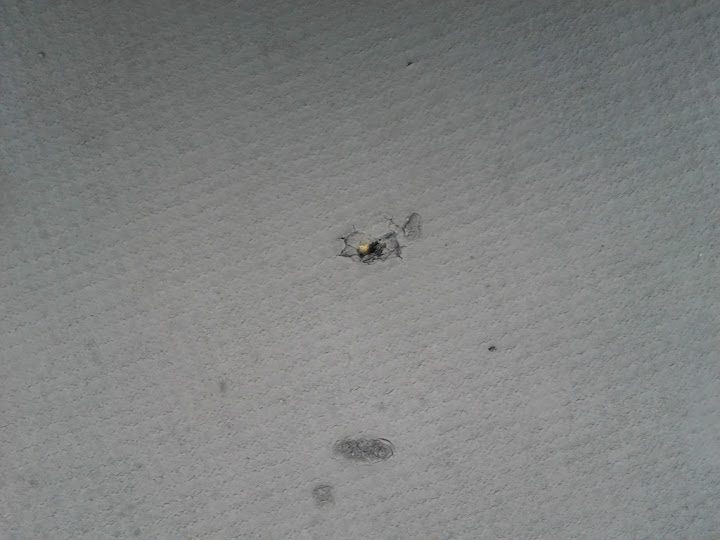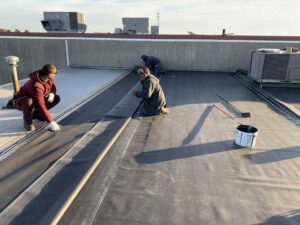Property managers understand that the integrity of a commercial roof is not just about weather protection. It’s about safeguarding assets, ensuring tenant satisfaction, and maintaining operational (and budget) continuity. Among the various roofing options, EPDM (Ethylene Propylene Diene Monomer) membranes are a popular choice due to their durability, cost-effectiveness, and ease of maintenance. However, like all systems, EPDM roofs follow a predictable lifecycle. Understanding this lifecycle is critical to planning maintenance, budgeting for capital expenditures, and minimizing disruptions for tenants and their clients.
-
Installation and Early Years (0–5 Years)
- EPDM is a synthetic rubber material available in large sheets (often 45 to 90 mils thick), usually black, though white versions are available for reflective benefits.
- Common installation methods include fully adhered or mechanically fastened systems. Ballasted systems have fallen out of favor in recent years.
- EPDM offers excellent UV resistance, flexibility in varying temperatures, and resistance to damage from hail and ozone.
- Installation typically occurs with minimal interruption to daily operations.
- Offers excellent energy absorption, which can help with HVAC efficiency in colder climates.
-
Prime Performance Years (5 to 15 Years)
- EPDM roofs require minimal maintenance but should be inspected semi-annually and after severe weather events.
- Flashings, seams, and penetrations will remain watertight if properly installed.
- This is the most stable period with low risk of leaks.
- Routine maintenance includes debris removal, gutter clearing, and ensuring drains remain unblocked.
-
Mid-Life Wear & Tear (15 to 25 Years)
- UV exposure and thermal cycling begin to degrade adhesives and seams.
- Common issues that occur are seam separation, minor surface cracking, and bridging or membrane shrinkage at edges.
- The most vulnerable areas include roof access points, HVAC curbs, skylights, and other penetrations.
- Expect increased maintenance needs and potentially higher service call frequency.
- Infrared scans may be recommended to identify trapped moisture or membrane delamination before signs of degradation or damage are visible.
- Budget planning should begin for potential restoration or eventual replacement options.
-
Late Life and Decision Point (25 to 30+ Years)
- The EPDM membrane typically reaches the end of its useful life.
- Common issues will be surface cracking, frequent leaks, and moisture infiltration into insulation.
- Repairs become less cost-effective and more reactive than preventative.
- Leaks can negatively impact tenants, cause interior damage, and risk inventory loss.
- At this stage, options include:
- Recovering (installing a new membrane over the old one, if conditions allow).
- Full replacement.
- Liquid-applied maintenance coatings for temporary life extension.
-
Best Practices for Lifecycle Management
Be proactive in your management style.
-
Annual Roof Inspections:
Include detailed photo documentation and condition reports.
- Roof Asset Management Programs:
Consider enrolling in a manufacturer or contractor service plan that includes regular preventative maintenance. -
Tenant Coordination:
Provide notice for scheduled inspections or repairs to avoid conflicts.
-
Authorized Roof Access:
Limiting roof access to credible contractors can go a long way towards minimizing punctures and tears caused by roof top traffic.
-
Capital Budgeting:
Begin setting aside funds at year 15 for eventual replacement or restoration.
Sustainability
At the end of their lifecycle, EPDM roofing membranes are often recyclable, reducing landfill waste and supporting environmentally responsible disposal practices. Additionally, many modern EPDM systems are compatible with reflective ‘cool roof’ coatings that can significantly improve energy efficiency by reducing heat absorption and lowering HVAC loads. For companies that have made sustainability commitments or are pursuing green building certifications, these features can meaningfully contribute to achieving environmental goals and demonstrating long-term corporate responsibility.
Final Thoughts
An EPDM roof, when properly installed and maintained, can offer 25 to 30 years of dependable service. For property managers, understanding this lifecycle means fewer surprise repair costs, better budgeting, and happier tenants. Implementation of a program of annual scheduled maintenance and regular inspections, your EPDM roof can continue to serve your property reliably, keeping both tenants and customers protected year-round.


